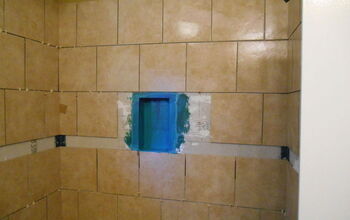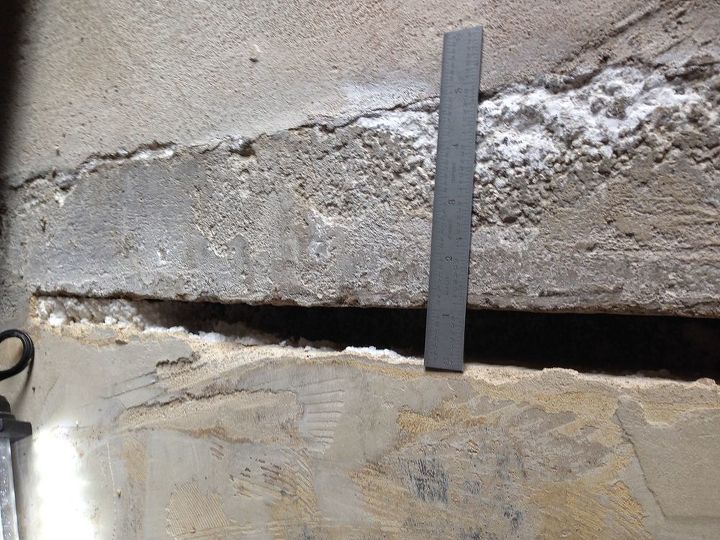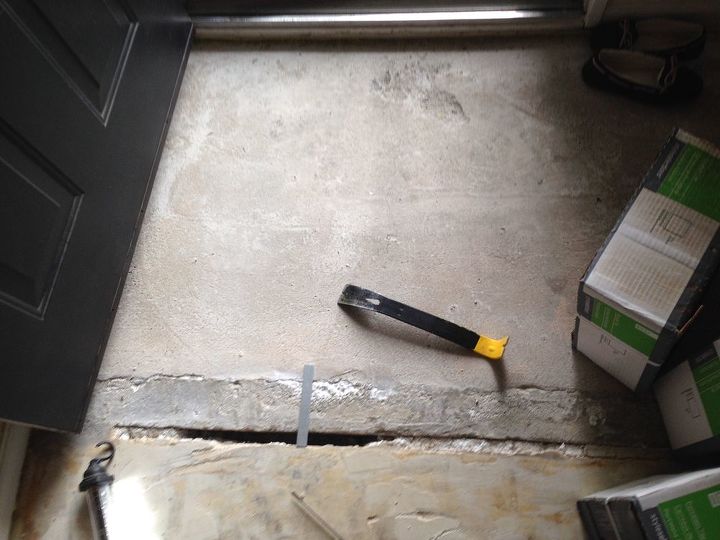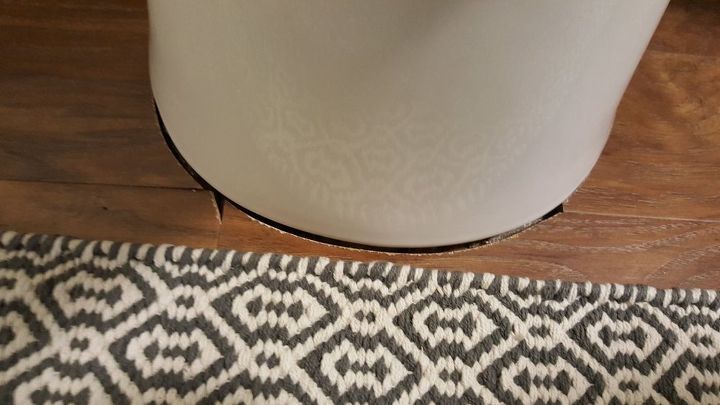Prep for tile - big gap to overcome....

-
You might be able to have the gap filled with a special epoxy, but I'd definitely get a professional to look at this. In order to have good looking, long lasting tile work, you really need to have a stable and level surface.
 Janet Smith
on Nov 16, 2013
Helpful Reply
Janet Smith
on Nov 16, 2013
Helpful Reply -
-
That will require an isolation membrane such as Kerdi type install or Schluter products made for this Schluter-KERDI - Schluter-Systems www.schluter.com/8_1_kerdi.aspxSchluter-KERDI is a pliable, sheet-applied, bonded waterproof membrane and vapor retarder with limited crack-bridging capabilities. It is made of soft ... NO other fix will last.
 Spheramid Enterprises
on Nov 17, 2013
Helpful Reply
Spheramid Enterprises
on Nov 17, 2013
Helpful Reply -
-
Here's a better link. http://ecomfort.com/kerdi-200-10m-bonded-waterproof-underlayment-membrane-3-3-x-33--4355.html?utm_source=shopzilla&utm_medium=product_search&utm_campaign=shopzilla&utm_content=4355 There is also a product that is called WEDI board that is a cemntitious skrim over a foam, that will also work, and give some thermal break. One other thing , place a crack monitor strip across it and be 100% sure that there is NO movement at all. That may require some work to resolve if it is happening. They sell them for basement wall cracks.
 Spheramid Enterprises
on Nov 17, 2013
Helpful Reply
Spheramid Enterprises
on Nov 17, 2013
Helpful Reply -
-
Just keep checking it for movement in both planes, if it exhibits one slab lifting and the other not, then ya have issues. There are high tech gauges but for a one time use probably not cost effective. Google it up , there are plenty of good info sites out there.
 Spheramid Enterprises
on Nov 17, 2013
Helpful Reply
Spheramid Enterprises
on Nov 17, 2013
Helpful Reply -
-
There is a chemical cure concrete that you can pore in that will bind, its about 350 per pail, and I think its from Sika. You could lay down a ditra layer for extra protection that will allow for movement of the layer below. Ditra is also the thinnest of all the layers that you could put. Check it out on http://www.schluter.com/6_1_ditra.aspx
 Floor Coverings International Mississauga & Premier Group
on Nov 17, 2013
Helpful Reply
Floor Coverings International Mississauga & Premier Group
on Nov 17, 2013
Helpful Reply -
-
Look , you don't have to go through all the things everyone is posting ...Just use " Thin set " to fill in the crack ...That's the same stuff you are going to use to adhere the tile to the floor..I run inot this all the time and that's what I do ;;;Mix you up a small batch and pour it in the crack , til it levels off at top ..Let that set til it's firm and you are ready to lay tile ...Really quite simple fix .. :)
 Terry's Flooring
on Nov 17, 2013
Helpful Reply
Terry's Flooring
on Nov 17, 2013
Helpful Reply -
-
Go find that foam and stuff it back down in the crack before you go over it with the thin set ...Please, don't make a mountain out of a mole hill with this ... :)
 Terry's Flooring
on Nov 17, 2013
Helpful Reply
Terry's Flooring
on Nov 17, 2013
Helpful Reply -
-
simply fill with hydraulic cement or grout
 C&K Custom Remodeling
on Nov 17, 2013
Helpful Reply
C&K Custom Remodeling
on Nov 17, 2013
Helpful Reply -
-
I agree with Terry's flooring it is not a big deal at all ,Just fill in with thinset mortar let dry,Then start your tiling,Good luck .
 Frye finish carpentry & handyman services
on Nov 17, 2013
Helpful Reply
Frye finish carpentry & handyman services
on Nov 17, 2013
Helpful Reply -
-
'Rapid Set' non shrinking crete mix, Home Depot. Its about $17.00, mix wet enough to pour, then pour directly into the crack until it's at level, when its almost dry trowel it smooth.
 Tony Perez
on Nov 17, 2013
Helpful Reply
Tony Perez
on Nov 17, 2013
Helpful Reply -
-
Concrete shifts and settles with the ground and cracks are inevitable. That's why tile directly on concrete has grout separations and tile breakage. A floating floor is better. IE: plywood over concrete or wood flooring.
 Debbie Harris
on Nov 18, 2013
Helpful Reply
Debbie Harris
on Nov 18, 2013
Helpful Reply -
-
Did he say he was in a flood area, didn't see that? Also have had wood flooring on concrete in basement of my house for 25 years with no problems. Floods can occur anywhere and on any floor. IE hot water heaters, tub overflow, rain or water rising in pond, river or coastal etc... However a gap where foundation slabs meet really should not have anything other than flexible flooring such as carpet, vinyl, or some kind of wood or laminate. Even the plywood I mentioned earlier should not cross over the slab joint, it will shift and whatever is on it will want to go with it. This guy wants a "long lasting" solution and only flexible flooring will work without cracking or breaking. If he's just going to use tile, the tile should not cross the gap or it WILL shift and one side will end up higher than the other. My advise is fill the gap and cover with a FLEXIBLE flooring.
 Debbie Harris
on Nov 18, 2013
Helpful Reply
Debbie Harris
on Nov 18, 2013
Helpful Reply- See 1 previous
-
-
That crack shows that something is shifting in the ground, or ground level. Even if you fill it in with whatever everybody is saying, the floor might shift, crack and buckle again. I would fill the crack in with something that is recommended by someone at your home improvement store. (Bring pics with you to Home Depot, Lowes etc) Then when dry I would use a floating floor and not tiles. Why take the chance of the floor cracking again? If it doesn't crack in the next year, it might in a couple of years. Then again you could call and get a foundation expert to stop by and give you a Free Estimate. They could tell you exactly what would happen with all the options everyone has given you. Hope everything works out for you. I know it is one big headache for you right now. I have one myself. I have two showers in my main bathroom. One regular with a bath tub, and the other one is a stall with glass door. Since we bought our house over twenty years ago, we have always used the shower stall. (We used the tub only when my kids were young). Anyway over one month ago I noticed a four inch size stain on the ceiling at the bottom of our stairs going to the second floor. I showed my husband and of course he had to poke it. Well the ceiling in that area is soft, which means the shower stall is leaking. Thank god we have another shower. This could be a large job or small job. We had intended on renovating our bathroom and replacing the tub shower with a walk in one with nice sliding glass doors, and beautiful large ceramic, marble or slate tiles, but we would have to use the shower stall while this reno was in process. Now with the shower stall leaking and god only knows what is in between the floor, this has caused a headache that will be there until we get to it. It isn't leaking anymore, because of course we aren't using the shower stall, and everything is dried up now. We have other renovations to get to in about two weeks, after our daughter moves out. So the bathroom shower stall is on the list, and will be a headache until we find out what exactly the problem is. Anyway sorry for the story. Just had to tell you about my headache. I hope your problem gets solved. Let us know what you ended up doing.
 Kim Dagenais
on Nov 18, 2013
Helpful Reply
Kim Dagenais
on Nov 18, 2013
Helpful Reply -
-
I agree with Tony Perez and Frye Finishing. No one can guaranteed the ground wont shift ae: you cant guarantee cracks will not return in concrete. No more that you can predict a tremor or earthquake. Fix it and forget about it nature will take its coarse and there is nothing you can do to stop it. Except pray!
 Bordeaux Construction Services
on Nov 18, 2013
Helpful Reply
Bordeaux Construction Services
on Nov 18, 2013
Helpful Reply -
-
I think I was not clear, the gap is simply a result of two slabs one older, one newer, next to each other. It's not a crack, it's a gap. I just want to "bridge the gap". I appreciate all the recommendations....
 David D
on Nov 18, 2013
Helpful Reply
David D
on Nov 18, 2013
Helpful Reply -
-
Even more reason for the isolation membrane, a cold joint in a slab is gonna make a tile failure for certain, even if it is pinned properly. It's not worth not dealing with it ahead of time.
 Spheramid Enterprises
on Nov 19, 2013
Helpful Reply
Spheramid Enterprises
on Nov 19, 2013
Helpful Reply -
-
A real good source for professional help is the John Bridge tile forum, I'd trust those opinions over just any internet source. http://www.johnbridge.com/vbulletin/index.php I'm 100% certain you will find, it's not ok to just fill it and forget it.
 Spheramid Enterprises
on Nov 19, 2013
Helpful Reply
Spheramid Enterprises
on Nov 19, 2013
Helpful Reply -
-
Lol...I have over 25 years Installing Ceramic Tile , it's just an exspansion joint from old to new ...Nothing is gonna shift , so just put the foam back in it and spread your thin set and lay tile ...You start listening to these people you'll end up spending a lot of money for nada...
 Terry's Flooring
on Nov 19, 2013
Helpful Reply
Terry's Flooring
on Nov 19, 2013
Helpful Reply -
-
David D. I’m so glad to be part of this forum, and to meet so many people with so much common sense. Almost everyone has shared the obvious answer, and everyone has expressed the key terms that, by themselves alone, almost scream the correct solution. We have the joint terms of butt, cold, expansion, and gap. All of these are different ways of saying the same thing : one part of the concrete floor is completely separate from the other. Even if it was pinned with re-bar, that is still a flexible hinge joint. One thing is for certain, seasonal moisture content in the ground immediately beside and beneath the “addition” slab WILL cause constant uplifting and dropping. A brittle surface like ceramic tile, which has a zero-tolerance for even miniscule shifts across that infernal gap, will fail sooner than later, as an ever widening tear in the tile precisely follows the gap beneath it. The correct “last forever” solution is flooring which can span the gap with enough “give” to flex with the potential shifting of the “addition” slab. For this situation my favorite is vinyl plank flooring, applied so that no plank joints, either edge or end, align on the gap. To prepare, get all the old foam out of the gap and refill it with as much silicone caulking as it will hold. This will diminish heat loss by moisture and air transfer through the gap. In addition, apply a thick poly-vinyl moisture barrier of whatever thickness your local code requires in a single sheet over all of the exposed concrete, old and new. This will hold condensation away from the bottom of the vinyl planks, and help keep the Foyer warm and cozy forever more. And yes I've done my fair share of all types of flooring installations. As a matter of fact, that is how I met my now husband who is an architect with more than 40 years of experience that you are now getting free advise from. Check him out at AndyBozeman.com, Americanhomeinstitute.com, 123homeprocess.com.
 Debbie Harris
on Nov 19, 2013
Helpful Reply
Debbie Harris
on Nov 19, 2013
Helpful Reply -
-
Debbie, the addition slab is sitting on the original slab (the front door was pushed out two feet to accommodate the stairs, so I ate up two feet of the patio). Does that change anything?
 David D
on Dec 09, 2013
Helpful Reply
David D
on Dec 09, 2013
Helpful Reply -
-
.A small strip of Kerdi is real cheap insurance, I'd never think twice of not doing it , just for peace of mind. Hell, I've seen scraps that big being tossed on many a job. I honesly can't believe any one would just slap over it and go..I guess pride in quality work to save a few minutes is gone.
 Spheramid Enterprises
on Dec 10, 2013
Helpful Reply
Spheramid Enterprises
on Dec 10, 2013
Helpful Reply -
-
I had already made a comment earlier, but I had another idea. In order for us to do our ceramic tile flooring in any room, we have to add a subfloor. What if you added a self leveling cement to the gap and surrounding floor to level it out completely? (Make sure to use a 4 foot level to make sure the floor is level before letting it dry). Then let it dry for 48 hours because of the deep gap and then add/use cement board/subfloor over the the area once the self leveling cement is dry. Then tile with mortar, let dry over night, and then grout the next day. I don't know how much flooring you are going to tile, but I asked my husband just to make sure and he agrees with the self leveling cement idea. He did his brother's bathroom last year, and had to use a large amount of self leveling cement because his floor was not level at all from the toilet moving towards the door, and in the towel closet in the bathroom. (His whole bathroom floor was like sloping to the left). My husband used his large 4 foot level and the floor was 100% level. You don't want to tile any floor if it isn't completely level. I hope this helps, and I don't know why I didn't think of it earlier. Hope you post pics of your finished tile job and the solution you finally used to remedy the problem.
 Kim Dagenais
on Dec 10, 2013
Helpful Reply
Kim Dagenais
on Dec 10, 2013
Helpful Reply -
-
best if you roll some waterproofing and crack prevention membrane.
 Hugo gonzalez
on Feb 12, 2016
Hugo gonzalez
on Feb 12, 2016
 Helpful Reply
Helpful Reply -
Related Discussions
How to get rid of mice?
We seem to have some unwelcome Mickeys and Minnies in our house. What is the best way to get rid of them?
How to remove popcorn ceiling with asbestos?
I want to remove my popcorn ceiling, but it has asbestos in it. How do I go about this safely?
How to caulk baseboard gaps?
How do I fill gaps at baseboard, should I caulk? If so, does anyone know how to caulk baseboards?
How to fix squeaky hardwood floors?
How do I fix squeaky hardwood floors?
Tile backsplash when there is existing countertop backsplash
We are thinking about how to add a backsplash to our kitchen. Unfortunately when we had our countertops installed we ordered a small backsplash that comes part way up... See more
Contractor mis-cut the floor when he put in the toilet
Hello, Our contractor didn't "measure twice, cut once" when he put in our toilet. Check out the photo. I'd appreciate any suggestions on a fix or a way to hide this m... See more







